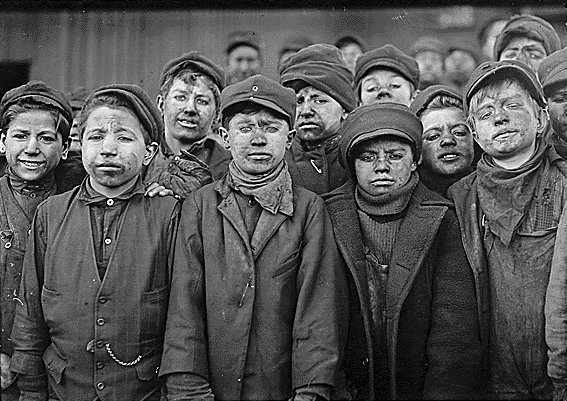Describe the Treatment of Children Who Worked in the Factories.
250 million children between 5 and 14 are forced to work in sweatshops in developing countries. Up to 24 cash back Children worked for the delight of the cotton mill owners there was a cheap alternative to paying children with actual money.

Child Labor Laws Definition Industrial Revolution History
Those complaining are beaten and abused.

. Less than half that many children had been employed 30 years before. In the mill as in most other factory industrial settings at the time work appropriate for children was clearly differentiated from work seen as appropriate for adults. The dirtiest jobs were given to the children.
According to History Crunch a child working during the Industrial Revolution typically made between 10 to 20 of an adults wage despite performing the same work. In 1850 a woman garment worker in a Cleveland factory earned 104 dollars. By 1900 roughly 17 million children under the age of 16 worked in factories.
The wages were super low and the hours were very unreasonable. There were little or no safety measures put in place in Victorian times so the occurrence of an injury and even death was not uncommon. The wages were pitiful.
Many times a child would be told to clean under machines even while they were running. For one they were cheap labor. In many ways the mill was seen as an extension of the family unit.
In the worst forms of sweatshops people are forced to work up to 72 hours straight without sleep. Because of the dangerous ways of city life such as endless smoke from coal powered factories poor hygiene and horrible working conditions many children were left without parents. In southern cotton mills children who.
Young orphan children in particular would find themselves victim. Below-minimum wages child labour and appalling conditions likened to a sweatshop a factory or workshop where employees work long hours for low money in conditions that are hazardous to health. They were also called female operatives.
Lack of sanitary facilities such as toilets. With this act children who worked in factories would now be given more safe regulations. Lots of the people that worked in these factories had fingers crushed or completely cut off.
The Act reduced the hours of work for children between eight and thirteen to six and a half a day either in the morning or afternoon no child being allowed to work in both on the same day except on alternate days and then only for ten hours. Female textile workers often described themselves as mill girls while affirming the virtue of their. OSHA Occupational Safety and Health Administration or anything faintly resembling an organization for safe working conditions did not existThe Factory Act was established in 1833 disallowing children under the age of nine to work in factories.
It was not uncommon for a person to work more then 12 hours a day and have to work 6 days a week. Working at a very young age 5 to 7 years old Worldwide the ILO estimates that at least 22000 children die at work each year. Many even saw children as key employees with several advantages over their adult counterparts.
In the Lodz ghetto for example the Nazis opened 96 factories. The ghettos served as bases for utilizing Jewish labor as did forced-labor camps for Jews in occupied Poland. Cases of physical sexual and verbal abuse are common and well documented.
In 1991 American labour activist Jeffrey Ballinger published a report on Nikes factory practices in Indonesia exposing a scandal. The term mill girls was occasionally used in antebellum newspapers and periodicals to describe the young Yankee women generally 15 - 30 years old who worked in the large cotton factories. Employers commonly paid women one-half to two-thirds of what a man doing the same job received.
At the factories children had no rights. Children may be driven into work for various reasons. Because of mens dislike for factory work many of the first workers in Ohios factories were women.
Some of the new laws that would focus on the youth in the factories were-No child workers under the age of nine-Children are not to work at night. 86 Although mill supervisors oversaw the children who performed these child-appropriate tasks they were often reluctant to discipline the children. Exposure to chemicals such as pesticides.
Under pressure from the public many state legislatures passed child labor laws which limited the hours children could work to ten hours per day but employers often disregarded such laws. Surrogacy was my final option she told Al Jazeera. The consequences are staggering.
5 to 9 year old Chimney sweeps would come out of a chimney covered from head to toe with soot. The working conditions were also very dangerous and not well taken care of. The Factory Act of 1844 is an extremely important one in the history of family legislation.
Lack of experience with machineries and sharp tools. Jews deemed unproductive by the Nazis were often the first to be shot or deported. Child labour can result in extreme bodily and mental harm and even death.
The ability to work could save ones life but most often only temporarily. Up to 24 cash back The Factory Act of 1833 was a major accomplishment for the proper rights of child workers. In factories women routinely faced discrimination.
Several factors can contribute to their hazardous working conditions. Most often child labour occurs when families face financial challenges or uncertainty whether due to poverty sudden illness of a caregiver or job loss of a primary wage earner. Child labor in sweatshops.
Ukraine has become an increasingly popular destination for foreign couples seeking affordable surrogacy services since they became legal in.

Child Labor Laws Definition Industrial Revolution History

The Children That Lived Through The Industrial Revolution Foundations Of Western Culture

Social Welfare History Project National Child Labor Committee
Comments
Post a Comment